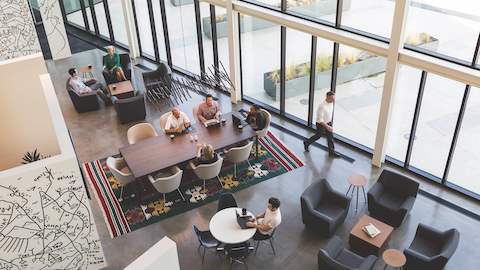Hogan Assessments
Hogan is a leader at helping companies choose and develop talent. Now, it has an office that does for its people what the company does for others.
Tulsa, Oklahoma, US
Download PDF (3.2 MB)
Hogan is in the people business, specifically helping companies find the right people to hire and the best ways to develop their talents and skills. The science of predicting workplace performance based on personality has been good to Hogan since Joyce and Robert Hogan pioneered the discipline and founded Hogan in 1987. Today, Hogan provides its solutions directly to companies and through partners in nearly 60 countries. Its staff of leading psychologists develop assessment tools that are translated into more than 40 languages and used around the world.
In considering Hogan’s recent achievements, current CEO Dr. Chamorro-Premuzic and the management team realized their company was world-class on all fronts, except for its facilities. Recent growth and two separate locations meant that the ill-fitting offices were getting in the way of the work.
“Our old facilities fostered silos,” says Chris Duffy, Hogan’s Vice President of Global Solutions. “They were eight-by-ten or ten-by-ten private offices with walls and doors. They all had two or three people in each one, sitting back to back. There was no place for us to get together as a group, or even have a team meeting. Walls created an “island” reality that reinforced a “silo” mentality. People emailed colleagues 20 feet away rather than trying to find them. “You couldn’t have a more discouraging place to create interactions with people,” Duffy adds.
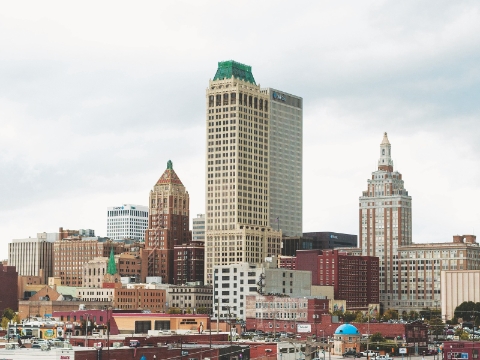
This expansive view of the skyline from Hogan’s new office building reinforces the company’s role in revitalizing Tulsa’s downtown.
Hogan’s management team decided that to get the world-class environment to match Hogan’s market-leading solutions and people, they’d have to build a new headquarters. They chose local architect and design firm Selser Schaefer and secured vacant property near downtown. As Principal and founding partner of the firm Janet Selser notes, “Downtown Tulsa is experiencing a rebirth, and like young professionals everywhere, they want to be downtown. The Hogan team wanted their building to take advantage of that trend.”
A Place with Personality
The appeal of Hogan’s new building starts with an exterior that honors the city’s past and points to its future. Glass walls echo the architecture of City Hall, charcoal panels celebrate the area’s manufacturing legacy, and classic brick is a nod to the historic buildings nearby.
The building’s interior makes an equally strong statement about Hogan’s character. “They’re in the personality business,” notes Selser, “so they came to us with a list of words and phrases that define their company’s personality.”
Making a list of traits to define its character fits perfectly with Herman Miller’s point of view on people, work, and the workplace. It’s called Living Office. Each Living Office is built on a foundation of what is fundamental to all people—their experiences and motivations, things Hogan employees are intimately familiar with—and adapts according to what is unique to each organization—i.e., Hogan’s singular purpose, its character, and the activities its people engage in.
Hogan employees encapsulate their philosophy in the mantra “work hard, play hard.” It’s a culture where talented individuals focus intensely on excelling in their roles, and where managers interrupt that focus with times to celebrate successes and achievements, gatherings where libations and food are staples.
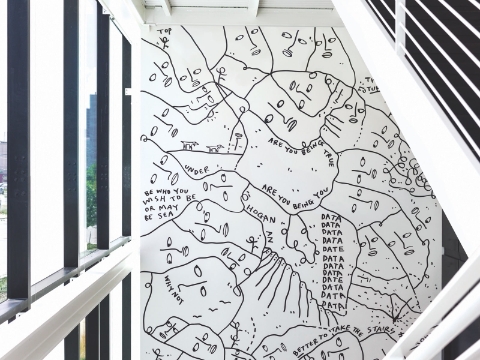
White wall surfaces in the new Hogan headquarters became “canvases” for artist Shantell Martin and her inspiring work, described as “a meditation of lines.”
The team at Selser Schaefer found the list a spirited articulation of the Hogan culture, and a valuable resource as it moved to designing the building’s interior. Team member Britton Howerton notes that “getting the list was delightful. It helped us know that we were all starting at the same place and heading in the right direction, or as the Hogan people described it, ‘designing an office so much for Hogan and its brand that it wouldn’t fit anybody else.’”
An inspiring trip to Herman Miller’s Design Yard facility in West Michigan suggested how the Hogan personality might take form. There, the team saw Herman Miller’s own Living Office in action. “On the way home,” Howerton recalls, “we asked them what they thought. They’re like, ‘Absolutely, this is the way to go, this is exactly what we needed to see, and now we can’t wait to see how it plays out in our new space.’”
A Place for Connecting
What played out at Hogan is a layout designed to address the company’s top business priorities. Number one for Hogan’s management team was to promote knowledge sharing and collaboration. The new office addresses that goal through the purposeful variety of settings all employees can use, depending on what they’re doing.
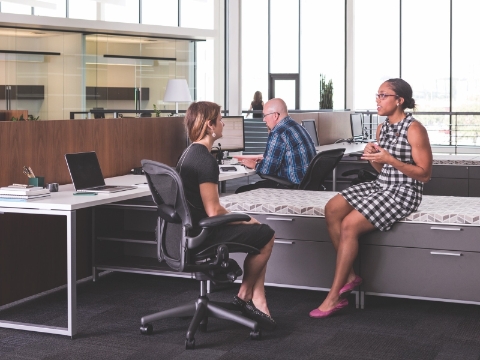
Canvas storage with cushioned tops provide a convenient place for guests to sit, which is important since the kind of collaboration that moves work forward happens most frequently at the desk and lasts a matter of minutes.
In Hogan’s old facilities, there were only two types of settings—one for individual work and one for group work. In the new building, there are eight different settings, chosen to support the various work activities common at Hogan. It’s not variety for variety’s sake; it’s based on what Hogan’s people need to do their jobs, which in turn reflects who the organization is.
Among the variety of settings, individuals have workstations clustered together as teams in what Herman Miller calls Hive Settings. Hives support side-by-side work, which is important since about 70 percent of collaboration happens at the desk or workstation.1
Ryan Ross, Managing Partner at Hogan, describes the collaboration he sees every day: “Someone who’s working with one of our partners, say in Southeast Asia, can be talking about a topic, and the person who’s responsible for Eastern Europe overhears part of the conversation. They can turn around very easily and chime in. Maybe they’re experiencing a similar situation, so they can talk about how to address it consistently, or suggest approaches they’ve tried. Teams sit together, so if they want to have quick conversations in groups of two or four people, it’s just a matter of sliding their chairs together or looking over a short, glass screen to have these quick conversations. So we’re getting instant collaboration.”
When quick chats among team members turn into longer conversations, people can step over to Cove Settings, purposefully located in close proximity. Here, conversations can continue without disrupting others. A clear line of sight between Hives and Coves lets people see whether someone else from their team is using a Cove.
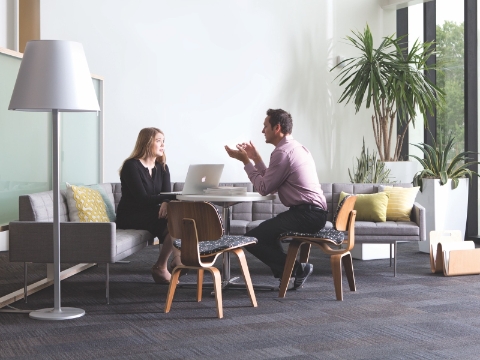
Cove Settings, located near primary workpoints, give people a place to start or continue a conversation without disrupting team members.
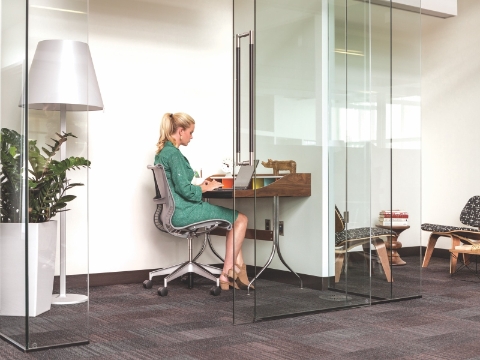
Small, enclosed settings, or Havens, located throughout the space offer a place to work without distraction, or without distracting others.
For focused work, people have small, enclosed settings, or Havens, located throughout the space. They let people work without distraction, or without distracting others. “People take themselves out of their normal workspace on a regular basis to go there and do things that require a bit more concentration,” notes Ross.
While Hogan’s old facilities lacked Meeting Spaces, the new office has several, in various sizes. Most have a decidedly less formal feel and provide collaborative space for two to four people. As Chris Duffy says, “These casual spaces are great. My team spends their life on the phone. And typically those calls include other team members, so having a space where they can also pull together a project team for a call is invaluable.”
Just as important, the new building has a setting to bring everyone together where leaders can share information about the business. Hogan calls it the Bistro. In Herman Miller’s parlance, it’s a Plaza—a vibrant communal space that helps people feel engaged, connected with coworkers, and in touch with the broader purpose of the organization.
“I think it has helped us the most,” adds Duffy. “We can now meet organization-wide, whether it’s impromptu or a formal get-together. Before, we had no space to bring everyone together, so people heard different messages. Now, we can bring everyone together in one space and make sure that we’re delivering a consistent message across the organization.”
A Place That Appeals
The new office is meeting another strategic goal Hogan leaders had for the project: to attract and retain top talent. “It’s a fun, flexible environment,” says Ross. “When we bring somebody in from out of town, and they’re trying to decide whether to take a job in Chicago, say, or Tulsa, showing them this modern, eclectic office space really levels the playing field.”
The new office, and the press coverage it’s received, has raised Hogan’s profile. Already the Human Resources staff at Hogan has seen an 82 percent increase in applicants after moving into the new office. That draw is significant given that Hogan depends on hiring and keeping psychologists with advanced degrees in order to stay on the cutting edge of personality assessment and development. A recent anecdote underscores the impact of the new space. “Two weeks ago,” says Natalie Tracy, Hogan’s Vice President of Marketing, “there was a guy who walked in and said, ‘I want to apply. I don’t even know what you guys do, but I know I want to work here. This is a really cool place.’”
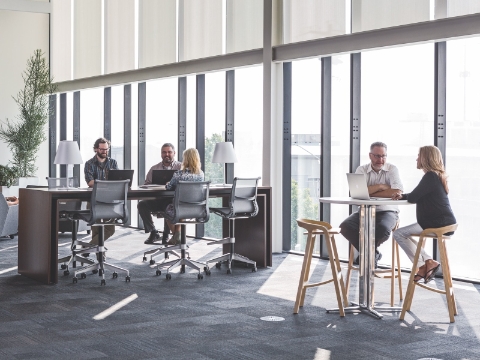
High-top tables and stools give Hogan employees settings throughout the office landscape where they can touch down to talk with colleagues or do work. As an added bonus, these settings allow people to vary their postures.
The new office is just as valuable for keeping employees engaged. “Our new workplace,” says Tracy, “coupled with the science behind our assessments has allowed us to virtually eliminate the possibility of our employees being disengaged.” That’s in strong contrast to recent Gallup poll numbers that show 70 percent of the global workforce is disengaged at work.2
The variety of settings in Hogan’s workplace means its people can essentially claim the entire space as their “office.” “One of the people on my team,” notes Duffy, “really takes advantage of the variety. In the morning, she’ll start in the Bistro and do follow-ups from the day before, then she’ll move to her desk and do some proactive stuff, then she’ll move to a call room or maybe a high-top table to have a couple of meetings.”
There’s even a rooftop space. “It’s the only building in Tulsa where you can work in, around, or on top of things,” says Tracy. “If it’s a beautiful day, you take your laptop up to the roof and work, alone or with your team.”
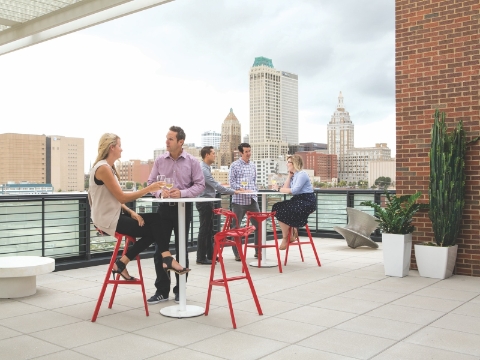
Choice in where to work extends to Hogan’s rooftop terrace. Additional features, like a full kitchen, make this Plaza setting equally adept at hosting employee celebrations and welcoming clients and partners from around the world.
A Place for Growth
Interest from prospective candidates feeds into the third objective the Hogan leadership team had for the new office: manage global growth. Hogan’s presence globally is already significant; it works with about 80 percent of Fortune 500 and 95 percent of Fortune 100 global companies. To expand that presence, the company has to grow through partners around the world who offer Hogan products as part of their consulting activities or global organizations that work with Hogan directly. This will mean adding more people in Tulsa to support the partners’ activities, translate assessment tools for clients, and develop resources for both to use—from journal articles to validation studies.
Canvas Office Landscape, Selser Schaefer’s product recommendation for the individual workstations, plays into Hogan’s desire for growth. Canvas, with its cohesive, versatile kit of parts, provides best-in-class support to the individual worker, even as it lets the organization change it or add to it as business needs evolve, or integrate other solutions around it.
For example, Canvas storage units have the ability to route power and data in them. They combine with the building’s raised floor, which carries HVAC, data, and power, to allow moving the furniture, trying new layouts, or adding new workstations. As Janet Selser says, “The flexibility is built in so their Living Office can be successful in the long run.”
Hogan’s Living Office has what it takes to evolve with the organization and its people, as their needs change and business opportunities arise. It’s a flexibility that relates directly to an understanding of Hogan’s purpose and character, and the unique activities of its people. It’s a flexibility that softens the uncertainty of the future.
The future aside, Hogan’s office is delivering for its employees right now. That’s evident in their feelings of pride. “You can sense the vibe,” says Natalie Tracy. “People are not only proud of what we do as a company, but also proud of the place they work, bringing their parents here to take a tour, taking family photos on our rooftop. And we’ve had great exposure in the community. It’s really cool to see your company in the headlines.”
As Janet Selser says, “They have events there all the time. It really has become a community building. They find that it’s allowed them as a company to be more community-minded.”
Notes
1. “The W’s of Work,” Herman Miller primary research study, 2011.
2. “State of the Global Workplace: Employee Engagement Insights for Business Leaders Worldwide,” Gallup, Inc., 2013.
